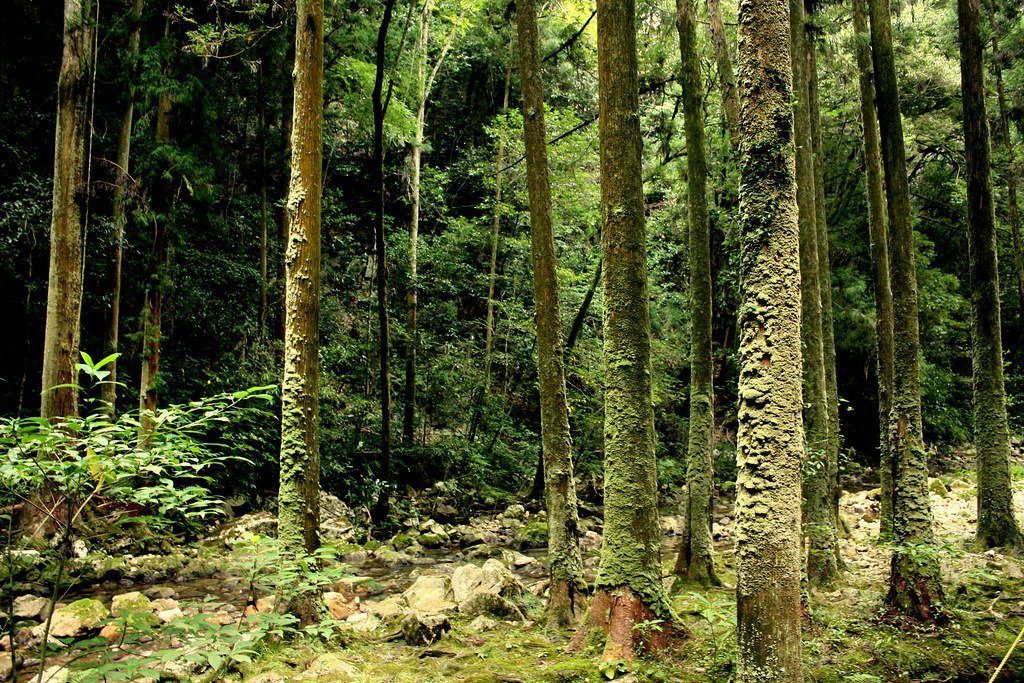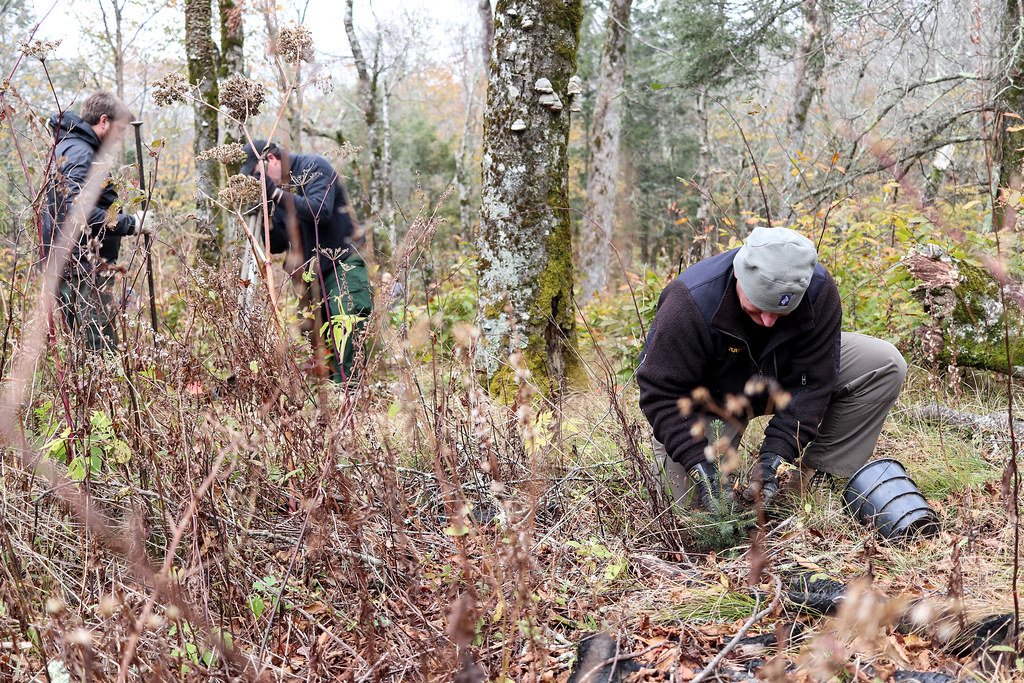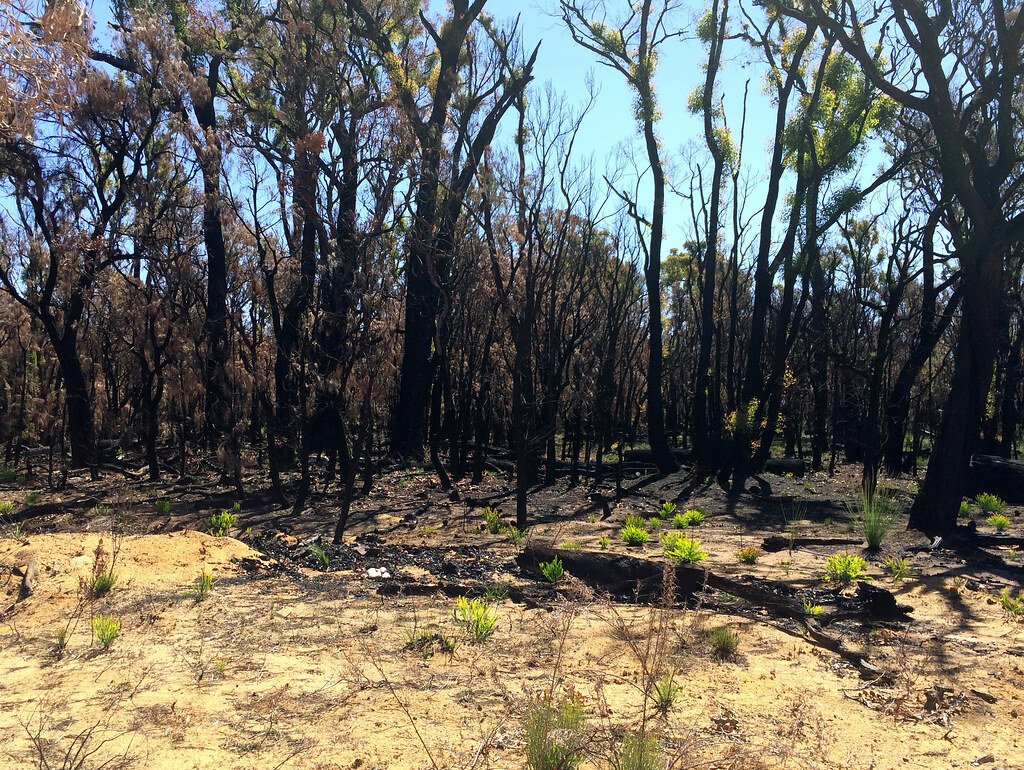Beneath your feet, as you stroll through any forest, lies one of nature’s most remarkable and sophisticated communication networks. It’s not the stuff of science fiction or fairy tales – it’s real, it’s happening right now, and it’s absolutely mind-blowing. Trees, those silent giants we’ve always thought of as solitary beings, are actually engaged in constant chatter with their neighbors through an intricate underground internet made entirely of fungi.
The Underground Internet That Puts Our WiFi to Shame

Picture this: every single step you take in a forest covers thousands of miles of fungal threads so thin they’re invisible to the naked eye. Through microscopic fungal threads known as hyphae, vast underground networks are formed, connecting trees, shrubs and other plants in a complex web of interdependence. Scientists refer to this phenomenon as the Wood Wide Web — a “forest internet” of sorts. This network isn’t just sprawling – it’s ancient, with some fungal networks spanning over 2,000 years and covering thousands of square kilometers. Studies in Canadian forests have shown that a single mycorrhizal network may span hundreds of trees and shrubs, and the mycelium of the largest fungi (e.g. Armillaria ostoyae) can cover over 9 square kilometres and be more than 2,000 years old.
What Makes This Forest Communication System Work

A mycorrhizal network (also known as a common mycorrhizal network or CMN) is an underground network found in forests and other plant communities, created by the hyphae of mycorrhizal fungi joining with plant roots. This network connects individual plants together. Think of it like nature’s version of fiber optic cables, except instead of carrying internet data, these fungal threads carry nutrients, water, and chemical messages between trees. It is a symbiotic relationship between plant roots and soil fungi, which benefits both sides: the plant gains improved access to water and minerals, while the fungus receives sugars produced by photosynthesis. What was once thought to be a local relationship — “one fungus, one plant” — is now known to be something far larger. Studies have shown that the hyphae of a single fungal individual can connect dozens, or even hundreds, of plants of various species, forming a continuous underground network through which both resources and signals can be exchanged.
Two Types of Fungal Networks Rule the Forest

Not all fungal networks are created equal – there are two main types that dominate different ecosystems. By far the most ubiquitous class is arbuscular mycorrhizal fungi (AMF), obligate biotrophs in the Glomeromycota that form arbuscules and sometimes vesicles within the root cells of hosts. Arbuscular mycorrhizal fungal symbioses dominate temperate grasslands, tropical forests and agricultural systems, but also associate with some temperate forest trees, such as members of the Cupressaceae and Aceraceae families. The other major class of mycorrhizas is the ectomycorrizal fungal (EMF) class. Although fewer plant species have been found to form symbioses with EMF, in comparison to AMF, the hosts of EMF tend to be widely dispersed, abundant and dominant members of their assemblages. For example, EMF hosts include most coniferous trees (all of the Pinaceae), the majority of woody shrub species in temperate and boreal forests and the Dipterocarpaceae, which results in EMF also being common in tropical forests. It’s like having two different internet providers – both work, but they serve different neighborhoods of the forest.
Trees Actually Send Chemical Text Messages

To communicate through the network, trees send chemical, hormonal and slow-pulsing electrical signals, which scientists are just beginning to decipher. When a tree gets attacked by insects, it doesn’t just suffer in silence – it literally calls for help through the fungal network. In one study, Simard watched as a Douglas fir that had been injured by insects appeared to send chemical warning signals to a ponderosa pine growing nearby. The pine tree then produced defense enzymes to protect against the insect. Stephen Woodward, a botanist from the University of Aberdeen in Scotland, warns against the idea that trees under insect attack are communicating with one another, at least as we understand it in human terms. “They’re not firing those signals to anything,” Woodward says. “They’re emitting distress chemicals. Other trees are picking it up. Even if it’s not intentional conversation like humans have, the result is the same – trees are influencing each other’s behavior through chemical signals.
The Shocking Truth About Tree Cooperation vs Competition

Everything we thought we knew about forest survival was wrong. Instead of being locked in brutal competition for resources, trees actually help each other survive. It shows instead that trees of the same species are communal, and will often form alliances with trees of other species. Forest trees have evolved to live in cooperative, interdependent relationships, maintained by communication and a collective intelligence similar to an insect colony. I knew that birch and fir were sharing carbon below ground — much against the prevailing wisdom that they only compete for light and also that the more that birch shaded Douglas fir, the more carbon was sent over to Douglas fir. So there was a net transfer from birch to fir that was sort of mitigating its shading effect. In this way the ecosystem was maintaining its balance — the birch and fir could coexist because of this collaborative behavior that was sort of offsetting some of the competition that was going on. It’s like discovering that your supposedly competitive coworkers have actually been secretly helping you succeed all along.
Mother Trees: The Forest’s Central Command Centers

A linchpin in the tree-fungi networks are hub trees. Also referred to as “mother trees,” these are the older, more seasoned trees in a forest. Typically, they have the most fungal connections. These ancient giants aren’t just surviving – they’re actively nurturing the next generation. Additional research has shown that large hub trees (that we call Mother Trees) transmit carbon through the mycorrhizal network to young seedlings in need. The carbon moves along a source-sink gradient, where the larger tree is the source of carbon and the seedling is the sink. “In connecting with all the trees of different ages, [the mother trees] can actually facilitate the growth of these understory seedlings,” she says. “The seedlings will link into the network of the old trees and benefit from that huge uptake resource capacity. And the old trees would also pass a little bit of carbon and nutrients and water to the little seedlings, at crucial times in their lives, that actually help them survive.”
How Trees Recognize Their Own Family Members

Here’s where things get really wild – trees can actually tell the difference between their relatives and strangers. A study on Douglas-fir trees at England’s University of Reading, indicates that trees recognize the root tips of their relatives and favor them when sending carbon and nutrients through the fungal network. Using seedlings, Asay and fellow researchers have shown that related pairs of trees recognize the root tips of their kin, among the root tips of unrelated seedlings, and seem to favor them with carbon sent through the mycorrhizal networks. “We don’t know how they do it,” says Simard. “Maybe by scent, but where are the scent receptors in tree roots? Scientists are still scratching their heads about exactly how this family recognition system works, but the evidence is undeniable – trees practice favoritism toward their relatives, just like humans do.
The Forest’s Early Warning System in Action

Imagine if your neighbors could warn you about burglars before they reached your house – that’s essentially what trees do for each other. When a tree faces danger from an invasive predator or disease, it can release chemical signals through the mycorrhizal network or into the air. Surrounding trees pick up these cues and respond by releasing hormones or chemicals to deter threats. For example, when a giraffe begins munching on acacia leaves, the tree detects the injury and emits a distress signal in the form of ethylene gas. Neighbouring acacias respond by pumping tannins into their leaves as a defence mechanism. As high tannins negatively impact the taste and nutritional value of the plant, giraffes actively avoid those plants. This early warning system can spread through an entire forest faster than you can say “timber.”
Resource Sharing That Would Make Communists Proud

Trees don’t just share information – they literally share food, water, and other essential resources through their fungal networks. Communication through mycorrhiza is not just about signals — it also includes resource sharing. Trees growing in favourable conditions (e.g. fertile soil, good sunlight) can pass on excess sugars to weaker neighbours, especially if they are their offspring. During drought, the mycorrhizal network may transport water from wetter to drier areas. Among species with different nutrient absorption capacities, the network acts like a system for exchanging microelements. As a sort of payment for their services, the mycorrhizal network retains about 30% of the sugar that the connected trees generate through photosynthesis. The fungi basically take their cut as middlemen in this underground economy.
The Billion-Year Partnership That Created Modern Forests

For more than 400 million years, mycorrhizal fungi and plants have formed partnerships that are crucial to the emergence and functioning of global ecosystems. This isn’t some recent evolutionary development – it’s an ancient partnership that literally shaped life on Earth. Mycorrhizal associations have profoundly impacted the evolution of plant life on Earth ever since the initial adaptation of plant life to land. It is estimated that mycorrhizal associations are present in: This means that without mycorrhiza, most plants simply would not survive. And that nearly every forest on Earth is, in reality, a connected, interdependent web of organisms — both visible and hidden beneath the surface. Without this fungal partnership, terrestrial ecosystems as we know them simply wouldn’t exist.
Trees Have Electrical Communication Too

Chemical signals aren’t the only way trees communicate – they also use electrical impulses, kind of like a primitive nervous system. Edward Farmer at the University of Lausanne in Switzerland has been studying the electrical pulses, and he has identified a voltage-based signaling system that appears strikingly similar to animal nervous systems (although he does not suggest that plants have neurons or brains). On the first area of underground communication among fungi themselves, the scientific debate and the media interest was sparked by a paper arguing that the exchanges of information among fungi transmitted across their hyphae networks via electrical spikes amounted to a sophisticated language. The study analysed species‐specific patterns of oscillations in extracellular electrical potential measured by differential electrodes inserted into a substrate colonized by the mycelium, or directly into sporocarps, the fruiting bodies above ground. It’s like trees have their own version of the internet, complete with electrical signals zipping through fungal fiber optic cables.
The Carbon Highway: Nature’s Massive Underground Economy

The scale of resource sharing through fungal networks is absolutely staggering. Here, we analyze nearly 200 datasets to provide the first global quantitative estimates of carbon allocation from plants to the mycelium of mycorrhizal fungi. We estimate that global plant communities allocate 3.93 Gt CO2e per year to arbuscular mycorrhizal fungi, 9.07 Gt CO2e per year to ectomycorrhizal fungi, and 0.12 Gt CO2e per year to ericoid mycorrhizal fungi. Based on this estimate, 13.12 Gt of CO2e fixed by terrestrial plants is, at least temporarily, allocated to the underground mycelium of mycorrhizal fungi per year, equating to ∼36% of current annual CO2 emissions from fossil fuels. That’s roughly equivalent to a third of all current fossil fuel emissions being processed through this underground fungal economy every single year. When dying trees release their stored carbon, about 40% of the carbon was transmitted through networks into their neighboring trees. The rest of the carbon would have just dispersed through natural decomposition processes … but some of it is directed right into the neighbors. And in this way, these old trees are actually having a very direct effect on the regenerative capacity of the new forest going forward.
When Human Activities Disrupt the Network

Here’s the sobering reality – when we cut down trees, especially the big old ones, we’re not just removing individual trees. We’re destroying communication hubs and severing the lifelines that keep entire forest communities connected. When felled, the tree’s established root system vanishes, disrupting nutrient sharing and communication. Neighbouring trees suffer as they lose access to vital resources and protective signals. This disturbs the intricate balance within the forest ecosystem, impacting regeneration and overall resilience. And our practices of salvage logging to get rid of dying trees, or trees that have just died or have been burned in wildfires — if we go in and cut them right away, we’re actually short-circuiting that natural process. Our studies suggest it would have knock-on effects to the regeneration coming up. They’re not going to be as well prepared for their lives coming forward. It’s like randomly unplugging servers from the internet and wondering why everything stops working.
The Scientific Controversy: Too Good to Be True?

Not everyone in the scientific community is convinced that the tree communication story is as rosy as it sounds. Among the critics is Dan Bebber, Co‐Director of Global Engagement for Biosciences at the University of Exeter, who referred to a recent paper showing that there is no evidence for this idea, only a positive citation bias. This paper refers to common mycorrhizal networks (CMNs) that connect the roots of multiple plants of the same or different species below ground and expresses concern that bias towards their positive effects in the scientific literature has stoked the popular idea of trees engaging in sophisticated interactions over the plant/fungal networks. The authors wrote that “The claim that mature trees preferentially send resources and defence signals to offspring through CMNs has no peer‐reviewed, published evidence.” “We found that mycorrhizal networks are indeed essential for the stability of many forest ecosystems, but rarely through sharing and caring among trees. Rather, it works like a trading ground for individual trees and fungi, each trying to make the best deal to survive,” explains Oskar Franklin, a study author and a researcher in the Agriculture, Forestry, and Ecosystem Services Research Group of the IIASA Biodiversity and Natural Resources Program. “The forest is not a super organism or a family of trees helping each other. It is a complex ecosystem with trees, fungi, and other organisms, which are all interdependent but not guided by a common purpose.”
The Experimental Challenges of Studying Underground Networks

One reason the scientific debate continues is that studying underground fungal networks is incredibly difficult. Mycorrhizal networks are delicate: dig up a root, and you’ve destroyed the very web of fungi and wood you wanted to study. To begin to figure out if a particular fungus really connects any two forest trees, scientists can sequence the fungus’s genes and construct a map of where genetically identical fungi are growing. This is a tremendous amount of work, Karst says, and she and her co-authors could find only five such studies across two forest types, comprising only two tree species and three fungi varieties. In a 2016 study in a Swiss forest, researchers sprayed some trees’ leaves with a particular isotope of carbon and found that isotope showed up in unsprayed neighbors. But it’s not clear that fungi are necessarily responsible for this transfer, Jones says. Resources can also move directly from root to root and through pores in the soil, and it’s difficult to experimentally separate those pathways without disrupting tree growth.
Forest Resilience: The Network Effect

Regardless of the ongoing scientific debates, one thing is clear, mycorrhizal networks make forests more resilient to environmental stress. The many hub trees and overlapping root systems form complex underground connections that allow trees to share water, nutrients, and even chemical signals in times of drought, disease, or damage. These networks act like a natural support system, enabling younger or weaker trees to survive harsh conditions by tapping into resources provided by their stronger neighbors. This hidden collaboration not only stabilizes ecosystems but also enhances biodiversity, reinforcing the idea that forest health depends not just on individual trees but on the strength of their interconnections below the surface.



